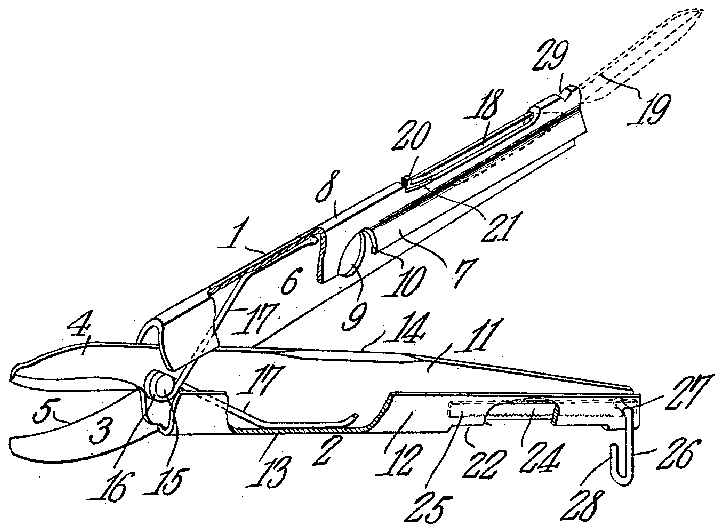
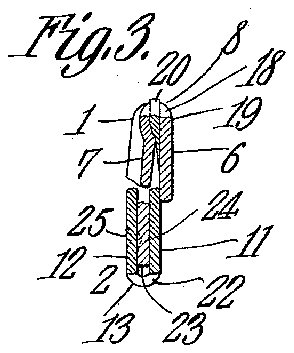
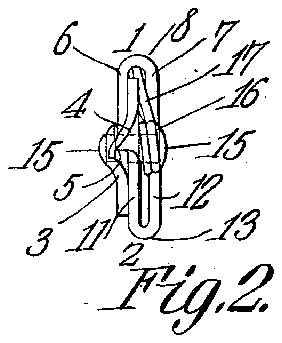
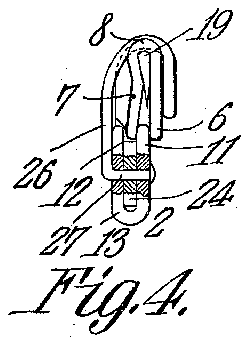
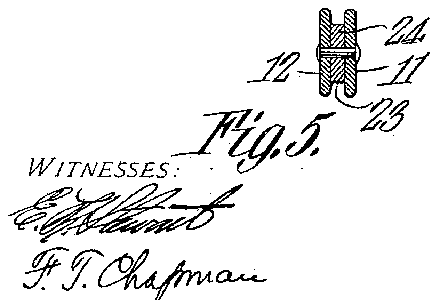
- 1handle
- 2handle
- 3blades
- 4blades
- 5matching cutting edges
- 6side
- 7side
- 8edge
- 9perforation
- 10recess
- 11walls
- 12walls
- 13respective edges
- 14edge
- 15pivot
- 16spring
- 17ends
- 18slot
- 19knife blade
- 20lug
- 21several notches
- 23roughened edge
- 24nail file
- 26clip
- 27clip 26 one leg
- 28overturned end
- 29notch
- 34blade
- 67members
Description
No.869,946. PATENTED NOV. 5,1907.
' A. L. TOLMAN.
MANIGURE IMPLEMENT.
APPLICATION FILED APB. 30,1907.
I V/ T/VESSES f dfl' ATTORNEYS specification, in which,
ABRAHAM LINCOLN TOLMAN, OF ORANGE, MASSACHUSETTS.
MANICURE IMPLEMENT.
Specification of Letters Patent.
Patented Nov. 5, 1907.
Ap' ieation filed April 30. 1907. Serial No. 371,104.
To all whom it may concern:
Be it known that I, ABRAHAM L. TOLMAN, a citizen of the United States, residing at Orange, in the county of Franklin and State of Massachusetts, have invented a new and useful Manicure Implement, of which the following is a specification.
This invention has reference to improvements in manicure implements, and its object is to provide a pocket tool comprising pair of shear or scissor blades, a nail file, and a knife blade and in connection therewith cigar cutter.
The invention is designed to be made of suitable material, such as sheet steel, with the handle portion stamped out from the steel plate in such shape as to present no sharp or cutting edges and to provide lodgment for a suitable nail tile and knife blade and to form the coacting parts of the cigar cutter, while the shear or scissor blades are suitably formed, each in one piece with the respective handle portion, and are secured together-by a suitable screw or rivet, with a spring tending to separate the blades and against the tension of which the blades are caused to pass each other in the act of cutting. The spring is so arranged as to maintain the blades elastically in proper operative relation one to the other.
The device is provided with a suitable locking means whereby the blades are held in the closed position when designed to be placed in the pocket or in a containing case suited to the pocket.
The invention will be fully understood from the following detailed description, taken in connection with the accompanying drawings forming part of this Figure 1 is a perspective view, with parts broken away, of the improved manicure implement; Fig. 2 is an end view, from the scissors end of the device; Fig. 3 is a section through the device across the nail file and knife blade; Fig. 4 is an end view, partly in section, looking at the end of the device remote from the scissors end; and Fig. 5' is a modification of the manner of securing the nail file in place.
In the drawings the structure is shown on a suitably enlarged scale, it being understood that the entire device is of a size about that of the ordinary curved,- blade scissors commonly known as nail scissors.
There is shown in the drawings two handle portions 12, each terminating in a blade 34 respectively, constituting the cutting blades of. a pair of scissors or shears, and these blades being suitably shaped with matching cutting edges 5 and either straight or, by preference, curved after the manner of ordinary curved nail scissors.
The handle l comprises a piece of sheet metal, say sheet steel,'liaving one side 6 of appropriate width and another side 7 of less width joined integrally along the outer edge 8. The members 67 of the handle 1 are in the main parallel one with the other and at a point about midway of the length of the member 6 there is formed a perforation 9 with a matching recess 10 in the member 7.
The handle 2 is likewise made up of two members 11-12 parallel with each other and integrally joined along their outer edges, as shown at 13. The member 11 has formed on it a knife or cutting edge 14 so located that when the two handle members are closed together, as will hereinafter appear, the knife edge 14 will pass between the members 6 and 7 of the other handle 1 entirely across the perforation 9 and the counter-notch 01' recess 10. The perforation 9 is of a suitable size to receive the end of a cigar and the cutting blade 14 will serve to shear off the end of the cigar.
The handles 1 and 2 are connected together by a pivot 15 adjacent to the butt ends of the blades 3 and 4. This pivot 15 is of such length as to receive sufficient turns of a spring 16, under compression, to maintain the two blades of the scissors in the proper cutting relation under the ordinary conditions of use. The ends 17 of the spring 16 are elongated and are passed into the handles 1 and 2 between the side members thereof until they abut against the respective edges 8 and 13 of these two handles. The tendency of the spring is such that unless otherwise restrainedthe handles will move apart around their pivot until the cutting edges of the blades 3 and 4 are separated along their entire length. In order to operate the cutting blades 3 and 4 of the scissors the handles 1 and 2 must be brought together by moving them about the pivot 15 against the stress of the spring 16 which, during this operation, is expanded and tends to force the blades continually into closer cutting relation.
Near the end of the handle 1 remote from the cutting blade 3 the edge 8 is cut away to form a slot 18. Seated in the handle 1 at this point is a knife blade 19 having the rear end upturned to form a lug 20 which projects slightly through the slot 18 so as to be easily reached by the fingernail of the user in order that the knife may be projected from out the rear end of the handle 1, as indicated in dotted lines in Fig. 1, or may be withdrawn into said handle. The knife blade 19 is of the ordinary taper type in cross section from the thick back to the cutting edge, and the side 7 of the handle 1 is bent in toward the other side 6 so as to conform in a manner to the shape of the knife blade, The latter is therefore firmly secured within the end of the handle 1 but at the same time may be easily moved out therefrom or withdrawn into the same. In order that the knife blade may be locked when withdrawn into the handle 1, the metal forming the walls of the slot 18 adjacent to the lug 20, when the blade is entirely withdrawn into the handle 1, is provided with several notches 21 which will serve as retarding means for preventing the knife blade 19 from being too easily started in a direction to project it from the handle.
The other handle 2 is likewise recessed, as shown at 22, to form a slot beneath which is presented the roughened edge 23 of a nail file 24 which may be firmly secured in the handle 2 between the walls 11 and 12 thereof by suitably indenting the metal, as indicated at 25. The nail file may be additionally secured by means of a clip 26 one leg 27 of which extends through both walls 11 and 12 of the handle 2 and through the corresponding end of the file housed therein. This clip 26 has an overturned end 28 arranged to straddle the rear end of the handle 1 and lock in a notch 29 formed in the edge 8 thereof. The clip 26 may be made of a continuous linlcii' so desired.
- function of maintaining the blades in operative cutting relation. There is also provided a nail file easily reached by the finger-nail, for taking off the rough edges 'left bythe scissors, and there isalso provided a knife bladefor any purpose for which it may be used. Also, as an additional implement of usefulness, the cigar cut ter forms an adjunct to the manicure scissors.
Instead of forming the walls 11-12 of the handle 2 by turning the metal over on itself these walls may be made of separate pieces, as indicated in Fig. 5, and the nail file may be secured between these walls by means of rivets such as indicated; or screws may be used in place of the rivets. By making the file of a separate piece and afterward securing it in the handle 2 the files may be made in quantities and hardened before being put in the handle, and the entire article maybe buffed and polished without danger of buffing the cutting edge off the file, as is liable to happen when the buffing is performed after the file has been inserted. Also, the walls of the handle 2, projecting above the cutting edge of the file, serve as a guide for and keep the finger nail in the groove while the file is being used.
I claim: I
1v A pair of shears or scissors comprising suitable handles, cutting blades formed thereon, a pivotal connection between the blades, and a spring surrounding the pivot and tending to maintain the blades in operative cutting relation, the said spring having extensions engaging the handles and tending normally to open the cutting blades.
A pair of shears or scissors comprising hollow handles, cutter blades extending therefrom, a pivotal connection between the handles, and a spring coacting with the pivot to maintain the blades in cutting relation one to the other and having extensions housed in said hollow handles and tending to separate the handles to open the blades.
3. A pair of shears or scissors comprising hollow handles, cutter blades formed on one end the1'e0f,a pivotal conection for the handles, an abrading tool imlnovably housed in one of the hollow handles and having its cutting edge exposed through a slot therein, and a knife blade housed in the other handle and constructed to be projected from the end thereof and provided with manipulating means extending through a slot formed in the said handle.
at. A pair of shears or scissors comprising sheet metal handles each composed of a single piece bent over to form two sides joined together along one edge and each provided with a cutting blade, a pivotal connection for the handles, and a knife blade movable longitudinally into and out of one of the handles and held therein by the compres sion of the sides of the handle one toward the other.
5. A manicure ilnplement having a handle formed of one piece bent on itself and slotted to constitute two side members, a lile between the side members and having its cutting edge below the edges of the slot, and fastening means passing through the side members and file for immovably holding the latter in place.
In testimony that I claim the foregoing as my own, I have hereto aifixed my signature in the presence of two witnesses. I
ABRAHAM LINCOLN TOLMAN.
Witnesses LEONARD M. GAGE, ALBERT OLIVER.

